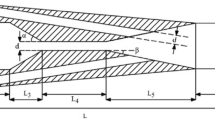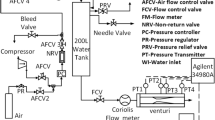Abstract
A cavitating venturi in the auxiliary feed water system of a nuclear power plant is a flow control device that limits the maximum flow rate in critical conditions. In this research, a numerical study was conducted to predict the characteristics of the cavitating flow in a venturi with various geometrical configurations. Assuming axisymmetric geometry and a steady state, equations of the flow field were solved numerically. The mixture model for the multi-phase flow and the standard k-ε turbulence model were adopted. The primary diffuser angle was varied to perform detailed parametric study. The flow and pressure variations, shape of the cavitation bubble, and corresponding flow control characteristics were summarized. Finally, the calculation results were analyzed to provide a physical basis for the design limits proposed in a previous patent. It is expected that the results of this study will be useful information for the future design of an optimized venturi.
Similar content being viewed by others
Abbreviations
- A :
-
Cross section area
- C d :
-
Discharge coefficient
- \({C_{{d_c}}}\) :
-
Discharge coefficient with cavitation
- \({C_{{d_{nc}}}}\) :
-
Discharge coefficient without cavitation
- K :
-
Pressure loss coefficient
- ṁ :
-
Mass flow rate
- ṁ c :
-
Mass flow rate with cavitation
- ṁ nc :
-
Mass flow rate without cavitation
- P :
-
Pressure
- P r :
-
Pressure ratio
- P u :
-
Critical pressure of the working fluid
- Q :
-
Volume flow rate
- Q r :
-
Volume flow rate ratio
- R :
-
Mass transfer rate
- Re :
-
Reynolds number
- t :
-
Time
- U, u :
-
Velocity
- \(\overrightarrow {{V_v}} \) :
-
Velocity of vapor
- x :
-
Throat length
- α :
-
Angle of the first diffuser
- β :
-
Angle of the second diffuser
- ε :
-
Turbulence dissipation rate
- Φ :
-
Vapor volume fraction
- κ :
-
Turbulence kinetic energy
- μ :
-
Viscosity
- ρ :
-
Density
- σ :
-
Cavitation number
- l :
-
Liquid
- m :
-
Mixture
- v :
-
Vapor
- in :
-
Inlet of cavitating venturi
- out :
-
Outlet of cavitating venturi
- th :
-
Throat of cavitating venturi nozzle
References
Korea Hydro and Nuclear Power Co., Ltd, Preliminary Safety Analysis Report (PSAR) of the Shin Kori Nuclear Power Plants 5 and 6 (2013).
C. E. Brennen, Cavitation and Bubble Dynamics, Cambridge University Press (2013).
S. Barre, J. Rolland, G. Boitel, E. Goncalves and R. F. Patella, Experiments and modeling of cavitating flows in venturi: attached sheet cavitation, European Journal of Mechanics — B/Fluids, 28(3) (2009) 444–464.
J. Decaix and E. Goncalvès, Investigation of three-dimensional effects on a cavitating Venturi flow, International Journal of Heat and Fluid Flow, 44 (2013) 576–595.
J. Wang, L. Wang, S. Xu, B. Ji and X. Long, Experimental investigation on the cavitation performance in a venturi reactor with special emphasis on the choking flow, Experimental Thermal and Fluid Science, 106 (2019) 215–225.
T. Ishii and M. Murakami, Comparison of cavitation flows in He I and He II, Cryogenics, 43 (2003) 507–514.
A. Preston, T. Colonius and C. E. Brennen, A numerical investigation of unsteady bubbly cavitating nozzle flows, Proceedings of ASME FEDSM”00 ASME 2000 Fluids Engineering Division Summer Meeting, Boston, MA, USA (2000).
S. M. Ahrafizadeh and H. Ghassemi, Experimental and numerical investigation on the performance of small-sized cavitating venturis, Flow Measurement and Instrumentation, 42 (2015) 6–15.
H. Shi, M. Li, P. Nikrtyuk and Q. Liu, Experimental and numerical study of cavitation flows in venturi tubes: from CFD to an empirical model, Chemical Engineering Science, 207 (2019) 672–687.
J. X. Zhang, Analysis on the effect of venturi tube structural parameters on fluid flow, AIP Adv., 7(6) (2017) 065315.
W. Yoon and K. Ahn, An experimental study on flow characteristics of cavitation venturi, Journal of the Korean Society of Propulsion Engineers, 19(4) (2015) 1–7.
J. Li, Y. Song, J. Yin and D. Wang, Investigation on the effect of geometrical parameters on the performance of a venturi type bubble generator, Nuclear Engineering and Design, 325 (2017) 90–96.
S. J. Seo, Analysis of flow restriction cavitating venturi using CFD, M.S. Thesis, Ajou University (2014).
B. G. Kim, Cavitating Venturi for Supplementary Water Supplying Line of Nuclear Reactor, KR 10-0597337B1, Korean Intellectual Property Office (2006).
ASME OM-S/G-2000 Standards and Guides for Operation and Maintenance of Nuclear Power Plants, American Society of Mechanical Engineers, New York, NY.
R. H. Perry, D. W. Green and J. O. Maloney, Perry’s Chemical Engineers Handbook, McGraw Hill (2008).
J. S. Kim, Numerical study on internal flow characteristics of venturi scrubber, M.S. Thesis, Changwon National University (2017).
B. Ahn, Numerical analysis of cavitation flow around an Ogive-cylinder and a venturi type, M.S. Thesis, Pusan National University (2007).
K. Y. Chien, Predictions of channel and boundary-layer flows with a low-reynolds-number turbulence model, AIAA Journal, 22 (1982) 33–38.
G. H. Schnerr and J. Sauer, Physical and numerical modeling of unsteady cavitation dynamics, Fourth International Conference on Multiphase Flow, New Orleans, USA, 1 (2001).
Acknowledgments
This work was supported by the National Research Foundation of Korea (NRF) grant funded by the Korea government (MSIT) (No. 2018R1D1A1B07046034). This research was also supported by the Technology Innovation Program (20000201) funded by the Ministry of Trade, Industry & Energy (MOTIE, Korea).
Author information
Authors and Affiliations
Corresponding author
Additional information
Recommended by Editor Yang Na
Hee Jin Hwang received her M.S. in Nuclear Engineering from the Pusan National University, Korea. She is also working for Korean Hydro & Nuclear Power. Her research interest includes design and management of secondary water system in the nuclear power plant.
June Kee Min received his Ph.D. degree from Korea Advanced Institute of Science and Technology, Korea, in 1999. Currently, he is a Professor at the School of Mechanical Engineering at Pusan National University in Busan, Korea. His research interest focuses on the development of advanced CFD models for various complicated flow and heat transfer problems.
Rights and permissions
About this article
Cite this article
Hwang, H.J., Park, J. & Min, J.K. A numerical study on the flow control characteristic of a cavitating venturi with one- and two-stage diffusers. J Mech Sci Technol 35, 1463–1472 (2021). https://doi.org/10.1007/s12206-021-0312-y
Received:
Revised:
Accepted:
Published:
Issue Date:
DOI: https://doi.org/10.1007/s12206-021-0312-y




